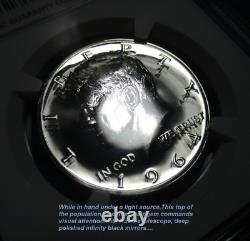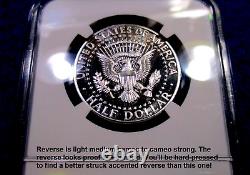1964 Kennedy Half Top Pop 1/0 Fyoi Pf69 Fs-103 Ddo Accented Hair Ngc Tv & Qrc





















Extremely Rare, Top Of The Population. FS-103, Double Die Obverse, Type I, Straight G Reverse, Ultra Rare NGC First Year Of Issue Label. 1964-P, Silver Kennedy Half-Dollar, Investment and Show Grade, Proof 69, Double D ie R everse, A ccented Hair, Type 1 Reverse, Straight G, boasting an Extreme Low Population of just. Proof coins, known in the Ultra Rare NGC, FS-103, DDO, label. I personally consider this frosty Gem May have the ability to attain a star up-grade from NGC.
"Without a doubt, one of the most difficult and scarce coins to acquire, in the entire Kennedy Half Dollar Series". Obverse Exhibits Pristine and spotless fields to the naked eyes. Coupled with exceptional frosting o n all elevated surfaces, throughout the obverse. Obverse may be worthy of a star grade from NGC.
Well struck, with fully Accented Hairlines, and well pronounced intricate details. While the reverse is well above Exceptional while cameo frosting goosebumps are visible throughout the reverse under magnification. Reverse is one of the finest that I have ever seen! And looks Proof 70+ all day long! All elevated portions of this silver canvas... Are surrounded by "Deep Hubble Telescope, Reflective Surfaces" also known as, Flawless Infinity Black, Deep Mirrored Fields! Some numismatic experts have placed the overall mintage of the "Accented Hair Variety" at right around 100,000 coins. This mintage is similar to the 1893 San Francisco, Morgan Silver Dollar! With only 100,000 coins being minted. The Accented Hair Variety, Kennedy half-dollar. Will Shirley hold a prominent place in the future of numismatics.. Condition Rarity, Variety Rarity, coupled with Low Population Rarity. Make this a true "Needle in a Haystack Find" An excellent addition to any coin collection..The Reverse fields of this gem! NGC (EIN) Encapsulation Identification Number 6808837-002.
This coin is protected by NGC, True View, Photographic Technology & With QR Code #80256900. Some Numismatic History on Multiple Strike Coins and Coin Values.
A very popular mint error type is the double-strike. It is dramatic in appearance and easily understood. Some of the most valuable mint errors are double-struck coins. Double-strikes are found on the earliest ancient coins all the way up to the modern-day coinage. Because of how coins are made, being "struck" with dies, it's an error type which will likely always be with us and that's a good thing! As the name would suggest, a double-strike is a coin that is struck twice. The double-struck coin typically will be struck correctly on the first strike, but then will be struck again either on-center or off-center. A double-struck coin is one that has just been struck twice, but the number of times a coin can be struck is infinite, and some coins are known with over 100 strikes on them. A multi-strike is a coin with three or more strikes. Multi-strikes can be either on-center or they can be off-center, but in order to qualify as a multi-strike, the coin must have at least three strikes present. It is not uncommon for a coin to be struck four or five or more times, although generally the more strikes a coin has the scarcer it will be. Why do double-strikes occur at all? Usually, it's because there is something not working correctly with the coin press' ejection system, and the feeder finger (which is what puts planchets between the dies and ejects them from the die) is not working correctly; it fails to eject the struck coin from between the dies.When this happens, the dies strike the coin a second, third, or more times until either the coin is ejected or a mint employee notices the press is not functioning properly, stops the press, and fixes whatever the issue is. Back before the striking of coins was fully automated, planchets were hand fed into the presses, and if a struck coin was not quickly grabbed by the press worker, the dies might come down a second time and give the coin another strike. There are many variations and combinations of double-strikes, which are too numerous for the purposes of this article.
However, one of the most common terms used with double-strikes is the term "uniface, " which means that one side of the strike occurred with another planchet blocking the strike, keeping it from receiving a normal strike on that side. This is less desirable than a coin struck on both sides.
A coin which is struck on both sides is termed die struck both sides. Double-struck coins that are die struck on both sides are usually worth 25-100% more than uniface coins. Condition rarity and low coin populations may also help to determine over all numismatic valuations as well.
Restricted signature is: to be signed by recipient only. Are opened up under video and audio surveillance cameras. Accompanied by a signature eye witness. You may return items for any reason up to.Unless otherwise stated in writing on the item advertised for sale. Thank You Very Much for viewing Investment-Grade Collectible Coins at Eye Candy Coins.

